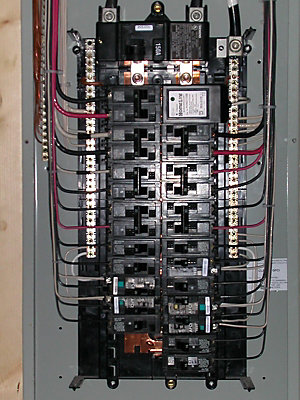WHY YOUR BREAKER PANEL COULD BE THE MOST DANGEROUS 6 SQUARE FEET IN YOUR HOME

For those who don't interact with one often, the breaker panel is a mysterious place, filled with fascinating, but serious-looking switches, numbers and labeled locations. What exactly does your breaker panel do and why should you care? Read on for details about why this small but significant space should be treated with care.
What it does
The breaker panel is often found in a basement, garage or utility room, but can also be found outside. It's the gateway to your home for all the electricity the power company delivers there. Behind the metal door, you'll see switches that are allotted to different portions of your home, which is why panels are often labeled with various room names. In some cases, large appliances have their own circuits.
When a surge of power overloads one of the circuits, perhaps from a malfunctioning appliance, your breaker panel is designed to automatically cut the power to that circuit, preventing your entire electrical system from being overloaded.
In many panels, an electromagnetic strip on each breaker registers the amount of energy traveling through it. Others register the heat of the current. If the current gets too high, the breaker trips. The trip will happen mechanically and the switch will move to the "off" position. Some breakers show a red flag when the circuit has been shut off. Advanced panels can even detect when someone has made contact with a wire in the system, tripping a circuit to avoid electrocution.
You should be able to easily reset your tripped breaker by moving it back to the on position.
What can go wrong?
Circuits that trip occasionally mean your breaker panel is most likely functioning normally. But frequent tripping can be your panel's way of warning you that the wiring in your home can't safely handle the electricity flowing through it, and the circuits need to shut off often to prevent overload.
You might have an old electrical panel in need of an upgrade. It likely does not carry sufficient amps to manage the demands of a modern household. Left un serviced, a panel with insufficient amperage can't regulate the power going to your electronics and appliances. These items can overheat regularly and be damaged. Heat can build up behind outlet covers, which become discolored. The National Fire Protection Association has found that an average of 50,000 home fires are started each year by electrical malfunctions.
If your tripped breaker will not stay in the "on" position for more than a few minutes, your panel itself could be the problem. And if you ever notice an acrid smell from your panel, see charring anywhere on it, hear a buzzing sound or find the panel feels hot to the touch, call an electrician immediately; these signs can indicate dangerous issues inside the panel.
How can I fix it?
If your panel is showing any of the signs of trouble mentioned above, it needs to be seen by a licensed electrician, who can tell you the source of the problem. Sometimes individual breakers can be upgraded, but if the panel is damaged from frequent power overloads, it may need replacing.
Defective breaker panels
Millions of homes built throughout the country between 1950 and 1985 had Federal Pacific Electric Stab-Lok breaker panels, which investigation has shown often don't trip when they should, continuing to supply dangerous amounts of electricity to a circuit, which causes intense heat, and in the case of these panels, sometimes fire. Zinsco panels, installed primarily in the '70s, have similar defects. If you have one of these panels in your home, contact a professional electrician immediately.
Your breaker panel is the key to all electrical activity in your home, and with the power going through it daily, it shouldn't be ignored. Rather than leave its condition to chance, schedule a visit from a skilled Ragsdale electrician today!
Related Reading
Join Our Email Newsletter
Receive updates, current news, promotions, and industry tips.
